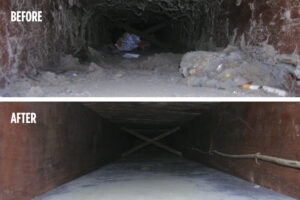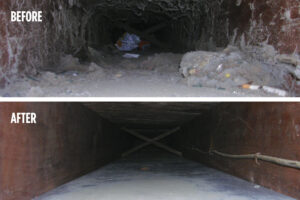Is all this talk about Energy Upgrades and Home Performance getting you down because you’d love to make improvements to your home, but lack the finances to make it happen?

Believe it or not, we were in the same boat (even though we both work in the industry). We were aware of the enormous benefits of a weatherized, insulated, and efficiently heated home for years before we finally pulled the trigger. I always just assumed we couldn’t afford it! I was completely in the dark about just how many financing options were available. That’s our home in the photo above, being tested for all things Home Performance related. That very home is now fully sealed/weatherized/efficiently heated/ventilated/basically every upgrade we could think of, for just under $100/month with the financing we received!
What types of financing are available and how to begin?
There are 4 basic types of financing for Energy/Home Performance/Heating upgrades.
- Energy Upgrade-Specific Financing: This is probably your best bet if you qualify, and it is the route we went for financing. Check out Puget Sound Cooperative Credit Union’s ENERGY SMART loans. PSCCU is a co-op bank geared toward local, environmental, and energy-savings solutions. And, they have fantastic rates! Must be in WA State to work with them, but check with your local financial institutions to see if your state has a similar program.
- A traditional Home Improvement Loan. This will likely be a little more expensive, but still a great option, and usually a better rate than a personal loan. Check with your current bank for their home improvement financing options.
- Personal Loan. Again, check with the bank you already do business with. A lot of times, you’ll get your best rate there, because they know you and want to keep your business. Personal loans tend to be a little more costly than other types of loans.
- Larger HVAC and Home Performance companies oftentimes have banks they work with, and you can receive significant deals, discounts, and lower rates by going through them. If you live in our area (Whatcom, Skagit, Island, San Juan, and Snohomish counties), check out Barron’s financing. We make available a 7.5% 10 year loan through a local bank, and a 6 mo. same-as-cash deal (if you qualify) through a nation-wide bank. Check with your local HVAC company to see if they have similar programs.
- Your local Human Services Organization (Bonus option!), though this is less about financing and more about low-income options. Some folks can receive free or very low-cost Home Performance/Weatherization work through the Human Services organization in their area. Our local agency is the Opportunity Council.
What’s Your Return On Investment (ROI)?
Here’s the nitty-gritty. If you’re ready to make the leap with financing, you’re probably asking just how long will it take to break even (between what you’re paying each month and what you’re saving in energy bills)? The basic formula goes like this:
Total cost of the project (divided by) your estimated annual savings = ROI
For simplicity’s sake, let’s say your project costs $10,000 and that allows you to save $1,000 per year in energy bills. Your ROI will occur in 10 years.
Where does one get these numbers? Your HVAC or Home Performance expert can give them to you.
What About Rebates?
The three main rebate programs for energy upgrades and home performance in our area are through Puget Sound Energy (PSE), Cascade Natural Gas (CNG), and the Community Energy Challenge (CEC). Here are direct links to the Applications for Homeowners: PSE Rebates , CNG Rebates, and CEC Information.
Beyond Finances:
Although finances are of primary importance for most people, there ARE other significant benefits to consider beyond the money saved.

- Peace of Mind: A new heating/cooling system and weatherization can set your mind at ease; allowing your family to relax without having to worry about shut-downs and repair costs.
- Health & Safety: There is ample evidence that people’s HVAC equipment and home are making them sick. An out-of-date, improperly-installed, or inefficient system can be very unhealthy, causing or contributing to myriad health-issues and diseases. And safety issues, such as carbon-monoxide leaks can be an immediate danger.
- Comfort: Most people want to create a warm, cozy, comfortable space for their friends and family. This is an undeniable benefit of investing in your home!
If this article has piqued your interest, I hope you will take a minute to contact your bank or HVAC contractor to get the ball rolling! You might be surprised by how affordable it is to create a cozy, efficient, healthy space!
Continue Reading
Posted in Clean Home, CNG, Energy Efficiency, Energy Savings, Financing, Green Living, Health, Healthy Home, Home Improvement, Home Performance, Incentives, Indoor Air Quality, PSE Rebate, rebates, Sick House, Weatherization | Comments Off on Home Performance Financing 101






